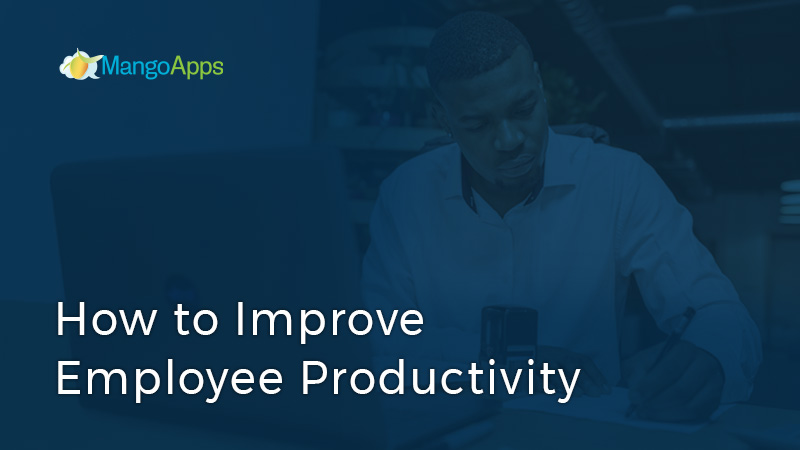
This article details out the benefits to improving employee productivity and provides actionable steps you can take to accomplish it.
The customer is king, right?
Not exactly… that old business adage isn’t as relevant as it once was. Companies are finally realizing that while customers are extremely important, employees also deserve attention and respect.
Your employees are the lifeblood of your business. It is critical that you connect with them and make them feel valued while providing them with the tools they need to work efficiently.
In this article, we’ll tackle a variety of different ways that your company can improve employee productivity and optimize your business operations.
8 Strategies to Improve Employee Productivity
#1: Provide a collaborative environment
Teamwork can make or break company culture.
When done correctly, a successful team can be a beacon of stability within your organization and yield increased productivity and collaboration across employees.
But how do we empower teams with the tools to communicate and collaborate effectively on a daily basis?
The answer? Digital workplace & collaboration tools.
Organizations worldwide rely on collaboration tools and digital workspaces to ensure that their workforce can share knowledge and resources while providing employees a space to collaborate and communicate on critical projects.
A digital workplace is a virtual platform that helps bring together the systems, people, and content within an organization. It focuses on equipping employees with the tools they need to collaborate and communicate effectively in a single digital space.
Organizations that opt for digital workplace technology are generally seeking to unify employee communications, collaboration, engagement, content sharing, and training within their company.
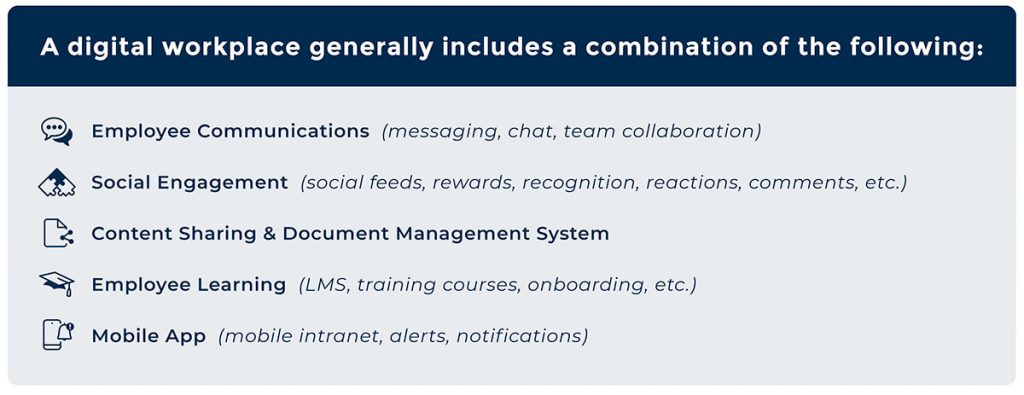
#2: Modern tools for productivity
There are a handful of collaboration tools that will help improve employee productivity. These collaboration tools can help replace email, allow you to store resources in one place, and help employees quickly access what they need, when they need it.
Below are two ways that collaboration tools can help improve employee productivity:
Replace Email
Email comes with many limitations. It’s difficult to keep track of information, conversations could be had that you’re not a part of, and it can lead to duplicate work.
With an instant message tool, you can focus on providing employees a better employee experience by eliminating the drawbacks of using email for internal communications.
In addition, organizations often don’t provide company associated email addresses to their frontline workforce. With an instant chat solution, you can empower employees to connect with their peers and communicate on job-critical tasks.
Store resources and tools in one place
By centralizing the resources and information within your organization to one place, you can ensure that employees can conveniently access the information they need quickly. When important resources are spread out across siloed tools, it can be quite challenging (and a massive waste of time) to retrieve it.
A modern digital workplace will come with a unified search feature, which allows employees to simply search the name of the resource they’re trying to locate.

Centralizing Employee Resources
In this case study, learn how TCG, a fully-remote government contractor, used MangoApps to:
- Create a central repository of resources
- Track engagement and see which employees view content
- Bridge the gap between their workforce
#3: Invest in employee learning
A workforce that isn’t constantly learning is a stagnant one. As you are aware, employee learning is a never-ending process. And as such, an environment of continuous learning must be established.
This starts when an employee is onboarded. You need to assess your onboarding process and make sure that new hires are equipped with the tools and resources they need so that they can hit the ground running.
It’s important that you are constantly educating your employees so that they can learn new skills, grow within their roles, and become even more valuable assets for your company.
A proper Learning Management System will help you keep employees up to date with required training while offering courses and resources that can further their development. A strong LMS can be the difference between a frustrating learning experience and a career-defining moment for your employees.
By providing your employees with learning programs and other educational opportunities, you can aid their professional growth and create a culture of learning within your workplace.
#4: Recognition program
Another way to improve employee productivity while also creating a positive work environment is by implementing an employee recognition program.
Whether you’re giving ‘kudos’ to a colleague, or celebrating a big team win, a good recognition program can improve company culture, boost employee morale, and create a space where employees can acknowledge each other’s milestones.
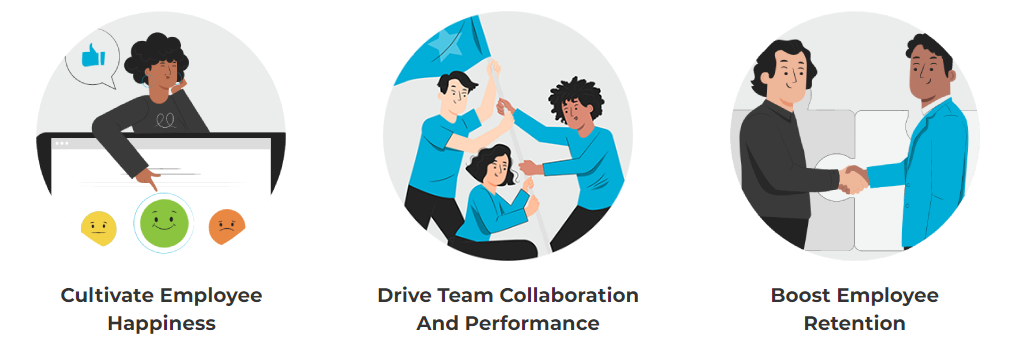
Most organizations are all too eager to pounce on employees when something goes wrong but are far too lenient in their praise and appreciation. This culture needs to transition into a more supportive environment that understands your people will make mistakes and encourages celebrating outstanding performance.
A positive company culture can be a driver of stronger collaboration and financial performance across teams, leading to improved productivity, efficiency, and business output.
#5: Gamification and rewards
Gamification can be another great way to improve employee productivity. You can try incentivizing staff with rewards and workplace bonuses to encourage employee engagement and get people excited.
Some benefits of gamification in the workplace include:
- Creating a workplace atmosphere of friendly competition
- Improved employee engagement and morale
- Quicker employee training
- Keeping new hires engaged during onboarding process
- Tracking and measuring employee learning progress
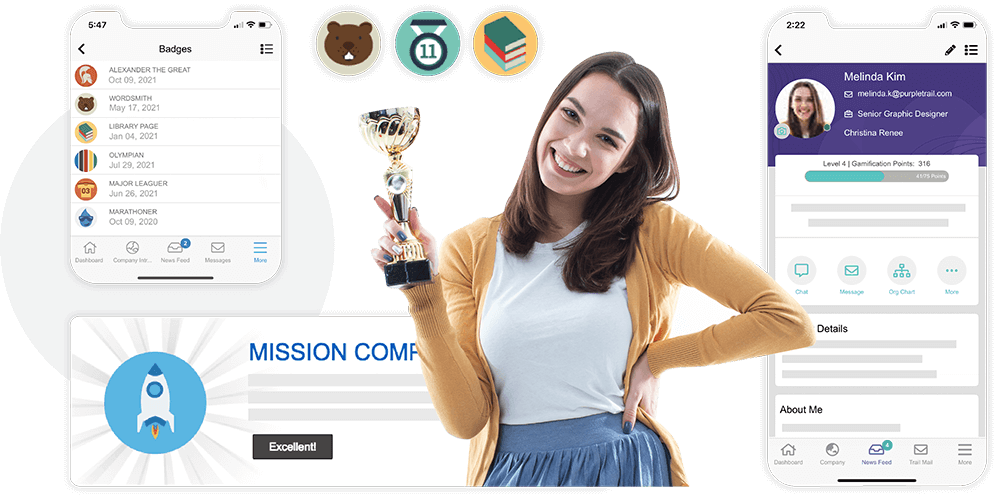
#6: Improve work-life balance
A healthy work-life balance can do wonders to improve employee productivity. Employees often prioritize work-life balance over their salary, when making career decisions.
Employees have their own private lives, people that they care for, and responsibilities that they need to attend to. Because of these factors, it may not always be suitable to work in the office.
This creates an incredible demand for workplace flexibility.

Allowing remote work will boost employee productivity by allowing employees to work in conditions that are best suited to their needs. This, in turn, increases company loyalty and naturally encourages increased commitment.
Did you know that 90% of employees report the same, or higher, productivity levels working from home compared to the office? Not only that, 55% of remote employees actually end up working longer hours than their counterparts, giving them an edge over their peers in terms of productivity.
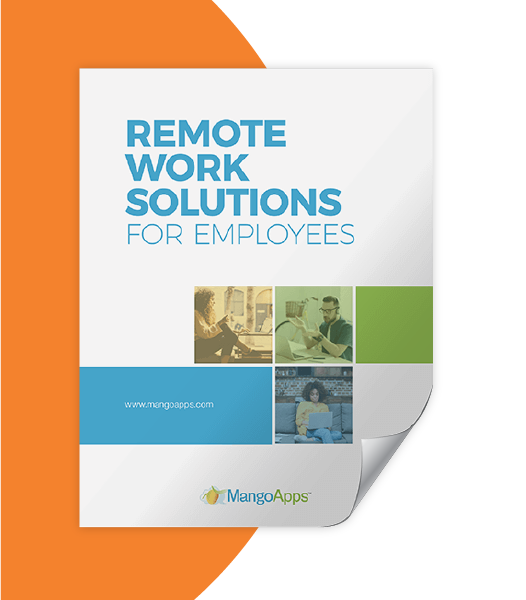
Get The Most Out of Your Remote Work Solution
In this whitepaper, you’ll learn how you can:
- Drive productivity at scale
- Connect with 100% of your workforce
- Maintain organizational compliance
- Build a growth-oriented culture
#7: Good managerial practices
Another way you can improve employee productivity is by practicing good managerial habits. When a manager isn’t clear on objectives/instructions, or they are micromanaging their employees’ work, it can directly lead to decreased employee productivity.
How a manager can improve employee productivity:
Set clear communication policies
Clear communication is the foundation of a healthy employee-employer relationship. Every department should have specific and effective communication policies in place for employee communication and team management.
Nothing lowers morale and discourages productivity quite like vague communication. It’s the manager’s responsibility to ensure that organizational objectives, instructions, and expectations are understood by everyone.
Avoid micromanaging
Micromanagement is incredibly paradoxical. The more you hover over an employee, the more disengaged they become. Give your employees the freedom they need to work and bring out their best. When you hire an employee, it’s a sign of trust that they can successfully do their job. Let them have a say in how they manage their workloads and strategies.
Try working with them to define goals, objectives, and KPIs, and then let them accomplish their tasks in the way they best see fit.
Gain insight from KPI’s
Use an employee’s Key Performance Indicator (KPI’s) as a learning and teaching tool, rather than as a blanket measurement of success. By using KPI’s, both employers and employees can get a better understanding of what areas need additional help/training.
When managers take the time to mentor employees through difficult areas, they can develop stronger relationships with everyone on their team. In addition, the insight you gain from KPI’s can boost employee productivity by helping managers get a better understanding of the needs of their team and by equipping employees with the tools and resources they need to learn any missing skills.
#8: Weekly status updates
For successful businesses, status meetings often become a necessary evil. While almost everyone agrees that meetings waste valuable time and energy, it’s impossible to stay productive without also being informed.
Collaboration tools allow companies to implement weekly status updates. This makes it easy to abandon time-consuming meetings without sacrificing the importance of staying up to speed.
A few ways that weekly status updates can improve employee productivity:
Strengthen existing meetings – Weekly status updates allow employees to post their progress, questions, and developments online to a shared company or team space. This gives leaders and coworkers the chance to read updates at their convenience and prepare answers ahead of time. While nothing will completely replace meetings, status updates make essential meetings faster, more focused, and more productive.
Improve team collaboration – Instead of trying to manage dozens of different schedules, employees can post, read, and respond to status updates whenever works for them. When employees have the freedom to work updates into their own schedule, thoughtful collaboration becomes easy, and never negatively impacts other responsibilities.
Maintain a written record – Weekly status reports are shared online, making them written rather than verbal communication. Unlike traditional status meetings, weekly status updates give everyone a tangible record to rely on. A written record also keeps goals visible, improves accountability, and simplifies idea sharing, helping everyone access important information.
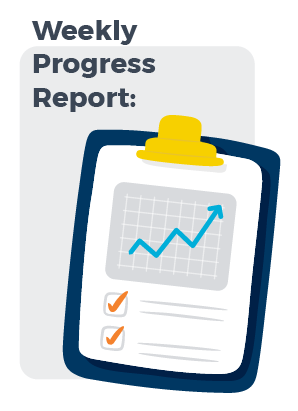
Filter out irrelevant updates – Employees rarely need to know everything shared at a status meeting. Different work roles, team projects, or areas of expertise often gather in status meetings to report their progress. But what’s essential to one project won’t matter to another team, leaving every employee at some point uninterested and unproductive. Instead of taking the time to hear irrelevant updates, online weekly status updates let employees filter information to find only what they need.
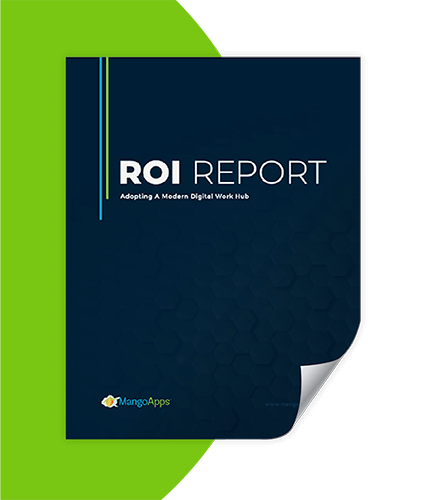
Calculate Your Company’s ROI
Want to learn some of the ROI you can receive when implementing MangoApps?
In this whitepaper, we give a detailed ROI breakdown on a case-by-case basis.
Tool sprawl – a toxin to employee productivity
When considering ways to improve employee productivity, one thing you should take note of is the resources and tools that your employees have at their disposal.
A lot of the times companies will continually add new tools to the point where it actually ends up hindering productivity. This is known as tool sprawl. It almost always gradually creeps up on organizations regardless of their industry.
At first, you’ll take on a new tool that solves a specific problem. Then your department designs an in-house program to address a unique need. When this starts happening over and over, a few simple solutions can spiral into an abundance of resources that can’t be managed.
If left unchecked, tool sprawl remains one of the biggest time-sucks when it comes to employee productivity. From bouncing between tools, trying to remember logins, and locating a specific resource, it can prove detrimental to company productivity at every level.
How tool sprawl hinders employee productivity
Damages individual efforts – Tool sprawl slows down every aspect of the employee experience. With resources spread out across multiple platforms, it takes a ridiculous amount of time just to find, open, and navigate everything you need. With information everywhere, it can be almost impossible to track down past conversations, relocate shared files, or reference recent reports.
Prevents team productivity – Tools sprawl does more than just mess with the individual work experience, it affects the collaborative environment as well. When information is scattered across different tools it becomes difficult for teams to gain insights and work well together. Without a simple way to share resources, express thoughts, and collaborate on ideas, work can never reach its full potential.
Deters corporate achievement– Even when teams establish a successful system, tool sprawl still finds a way to negatively impact the corporate environment. Devising customized sharing methods seems like a solution until work has to be transferred to another department. Suddenly, trying to integrate the tools and tactics of dozens of different teams can create a real problem. Instead of a seamless handoff, transitions become tedious reconstruction tasks.
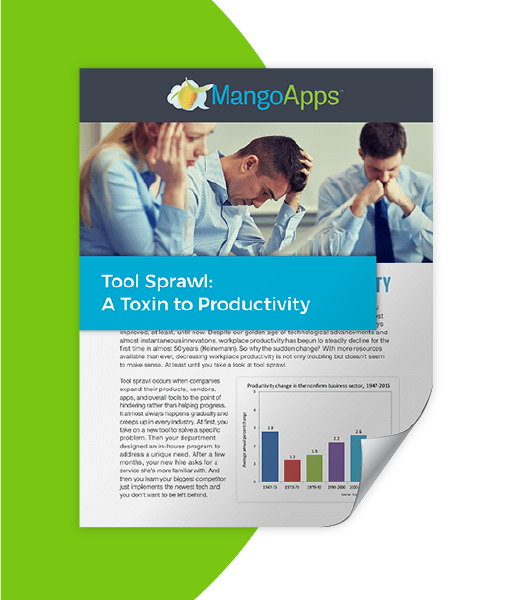
Why You Should Avoid Tool Sprawl
When you have too many tools and resources, you can actually hinder employee productivity.
In this whitepaper, we go over why tool sprawl is a toxin to productivity and how you can avoid it.
Improve employee productivity with MangoApps
All of these tools and resources can be impossible to navigate and is why we recommend implementing a modern digital workplace tool so that employees only have to go to one central place to access anything they might need to do their jobs.
Unlike disorderly tool sprawl, MangoApps is an integrated employee platform, providing companies with a truly consolidated workspace. Our individual, team, and company centered features help organizations break down silos and find success at every stage.
At MangoApps, we design tools to help companies create a successful work environment, encourage employee engagement and boost employee productivity.
To learn more about how MangoApps can help you transform your workforce culture through technology, contact us or schedule a demo today.







